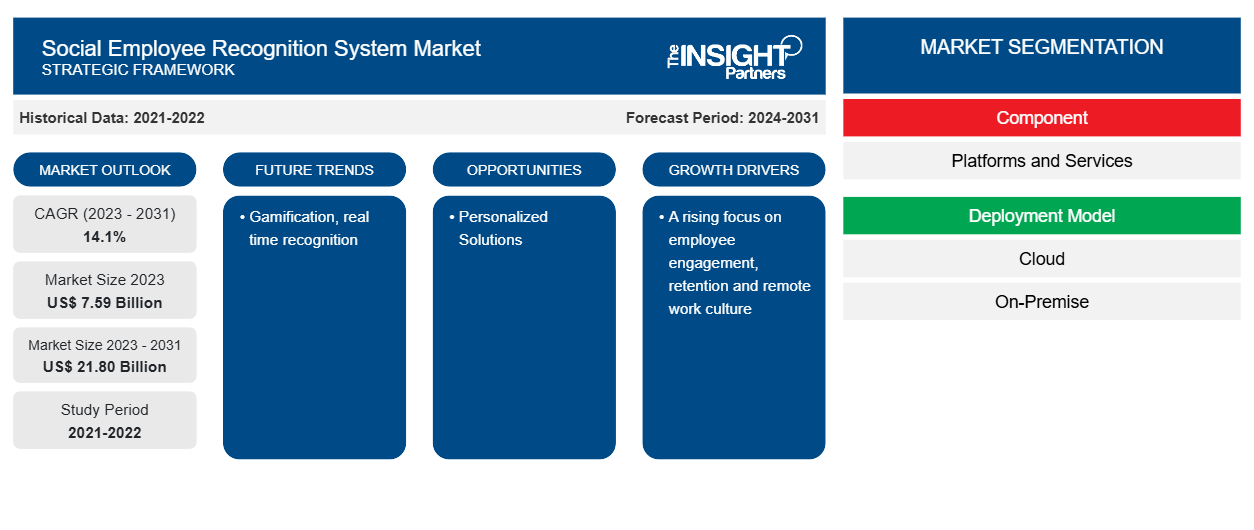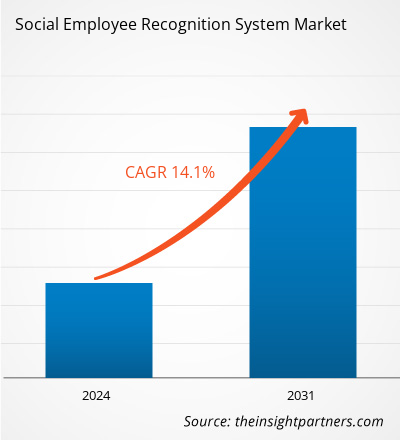The Social employee recognition system market size is projected to reach US$ 21.80 billion by 2031 from US$ 7.59 billion in 2023. The market is expected to register a CAGR of 14.1% during 2023–2031. Gamification and real-time recognition are likely to remain a key trend in the market.
Social Employee Recognition System Market Analysis
A modern employee recognition program is a way to recognize and honor the contributions of staff members that are in line with the varied and technologically savvy needs of today's workforce. It makes use of technology to provide quick, meaningful, and personalized recognition, fostering a healthy workplace culture and raising employee engagement.
Social Employee Recognition System Market Overview
Social recognition improves the bonds between leaders, coworkers, and employees. Interaction between deskless, in-office, and remote workers is made possible by it. Moreover, social recognition platforms—which are especially helpful in large organizations—assist in dismantling departmental silos by showcasing the accomplishments of many departments. For example, companies with the greatest staff engagement scores had 21% higher profitability, 10% higher customer evaluations, and 24% lower attrition, according to a Terryberry poll from 2024.
Customize This Report To Suit Your Requirement
You will get customization on any report - free of charge - including parts of this report, or country-level analysis, Excel Data pack, as well as avail great offers and discounts for start-ups & universities
Social Employee Recognition System Market: Strategic Insights

-
Get Top Key Market Trends of this report.This FREE sample will include data analysis, ranging from market trends to estimates and forecasts.
Social Employee Recognition System Market Drivers and Opportunities
Rising Focus on Employee Engagement and Retention to Favor the Market
As per the Haiilo 2024 survey, in the workplace, employee involvement boosts productivity. Employees who are engaged perform better than their disengaged peers. Employers with a high level of employee engagement make 21% more money overall. A study on workplace engagement conducted in the United States found that disengaged workers cost their employers between US$ 450 and 550 billion annually. This is driving the companies to increase their focus on employee engagement. Social employee engagement initiatives go a long way in enabling employee retention.
Personalized Solutions
For increased success, organizations should customize their employee recognition and rewards programs to meet the needs of both their staff and their business. Companies can gain a competitive edge by personalizing recognition for employees.
Social Employee Recognition System Market Report Segmentation Analysis
Key segments that contributed to the derivation of the social employee recognition system market analysis are XX.
- Based on the component, the social employee recognition system market is divided into platforms and services. The platforms segment held the largest share in 2023.
- Based on the deployment model, the market is divided into cloud and on-premise.
- Based on the reward type, the market is divided into gift cards, prepaid cards, incentive travel, and others.
- Based on the industry, the market is divided into retail, IT & telecom, healthcare, media & entertainment, travel and hospitality, manufacturing, and others.
Social Employee Recognition System Market Share Analysis by Geography
The geographic scope of the Social employee recognition system market report is mainly divided into five regions: North America, Asia Pacific, Europe, Middle East & Africa, and South & Central America.
North America holds a significant share of the social employee recognition system market in 2023. North American organizations, especially those in the US and Canada, have strong adoption rates for HR technologies and employee engagement programs.
Social Employee Recognition System Market Regional Insights
The regional trends and factors influencing the Social Employee Recognition System Market throughout the forecast period have been thoroughly explained by the analysts at The Insight Partners. This section also discusses Social Employee Recognition System Market segments and geography across North America, Europe, Asia Pacific, Middle East and Africa, and South and Central America.
Social Employee Recognition System Market Report Scope
| Report Attribute | Details |
|---|---|
| Market size in 2023 | US$ 7.59 Billion |
| Market Size by 2031 | US$ 21.80 Billion |
| Global CAGR (2023 - 2031) | 14.1% |
| Historical Data | 2021-2022 |
| Forecast period | 2024-2031 |
| Segments Covered |
By Component
|
| Regions and Countries Covered |
North America
|
| Market leaders and key company profiles |
|
Social Employee Recognition System Market Players Density: Understanding Its Impact on Business Dynamics
The Social Employee Recognition System Market is growing rapidly, driven by increasing end-user demand due to factors such as evolving consumer preferences, technological advancements, and greater awareness of the product's benefits. As demand rises, businesses are expanding their offerings, innovating to meet consumer needs, and capitalizing on emerging trends, which further fuels market growth.

- Get the Social Employee Recognition System Market top key players overview
Social Employee Recognition System Market News and Recent Developments
The Social employee recognition system market is evaluated by gathering qualitative and quantitative data post primary and secondary research, which includes important corporate publications, association data, and databases. A few of the developments in the social employee recognition system market are listed below:
- Achievers declared the opening of an Employee Experience Platform, which would serve as a single, centralized hub for employee experience initiatives. (Source: Achievers Solutions Inc, Press Release, September 2021)
- Terryberry introduces a comprehensive platform for employee engagement that includes Milestone Awards, Employee Benefits, and Recognition. (Source: Terrberry, Press Release, March 2023)
Social Employee Recognition System Market Report Coverage and Deliverables
The “Social Employee Recognition System Market Size and Forecast (2021–2031)” report provides a detailed analysis of the market covering below areas:
- Social employee recognition system market size and forecast at global, regional, and country levels for all the key market segments covered under the scope
- Social employee recognition system market trends, as well as market dynamics such as drivers, restraints, and key opportunities
- Detailed PEST/Porter’s Five Forces and SWOT analysis
- Social employee recognition system market analysis covering key market trends, global and regional framework, major players, regulations, and recent market developments
- Industry landscape and competition analysis covering market concentration, heat map analysis, prominent players, and recent developments for the social employee recognition system market
- Detailed company profiles
Frequently Asked Questions
Which region dominated the social employee recognition system market in 2023?
What are the driving factors impacting the social employee recognition system market?
What are the future trends of the social employee recognition system market?
Which are the leading players operating in the social employee recognition system market?
What would be the estimated value of the social employee recognition system market by 2031?
What is the expected CAGR of the Social employee recognition system market?
- Historical Analysis (2 Years), Base Year, Forecast (7 Years) with CAGR
- PEST and SWOT Analysis
- Market Size Value / Volume - Global, Regional, Country
- Industry and Competitive Landscape
- Excel Dataset
Recent Reports
Testimonials
Reason to Buy
- Informed Decision-Making
- Understanding Market Dynamics
- Competitive Analysis
- Identifying Emerging Markets
- Customer Insights
- Market Forecasts
- Risk Mitigation
- Boosting Operational Efficiency
- Strategic Planning
- Investment Justification
- Tracking Industry Innovations
- Aligning with Regulatory Trends





















 Get Free Sample For
Get Free Sample For